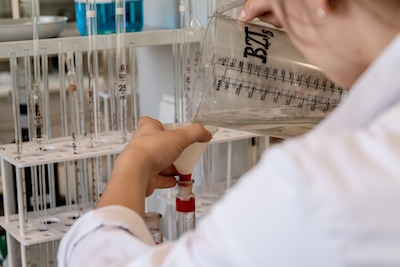
Do you know the differences between and endothermic and exothermic processes? Can you balance a redox reaction? The AP ® Chemistry exam tests topics and skills discussed in your Advanced Placement Chemistry course. If you score high enough, your AP Chemistry score could earn you college credit!
Check out our AP Chemistry Guide for the essential information you need for the exam:
What’s on the AP Chemistry Exam?
The AP Chemistry exam takes 3 hours and 15 minutes to complete. The exam consists of two sections: a multiple-choice section and free-response section.
|
Timing |
Number of Questions |
% of Exam Score |
|
|
Section 1 |
90 minutes |
60 multiple choice questions *Use of a calculator is not allowed. |
50% |
|
Section 2 |
105 minutes |
3 long-form free-response questions *Use of a calculator is allowed. |
50% |
AP Chem Topics
The concepts of the AP Chemistry Exam are broken down into six major themes defined by the College Board as the Big Ideas. Rather than learning multiple disparate topics, these Big Ideas interconnect principles within these topics that describe fundamental chemical phenomena. The six Big Ideas are as follows:
- Big Idea #1: The chemical elements are fundamental building materials of matter, and all matter can be understood in terms of arrangements of atoms. These atoms retain their identity in chemical reactions.
- Big Idea #2: Chemical and physical properties of materials can be explained by the structure and the arrangement of atoms, ions, or molecules and the forces between them.
- Big Idea #3: Changes in matter involve the rearrangement and/or reorganization of atoms and/or the transfer of electrons.
- Big Idea #4: Rates of chemical reactions are determined by details of the molecular collisions.
- Big Idea #5: The laws of thermodynamics describe the essential role of energy and explain and predict the direction of changes in matter.
- Big Idea #6: Any bond or intermolecular attraction that can be formed can be broken. These two processes are in a dynamic competition, sensitive to initial conditions and external perturbations.
Check out our Cracking the AP Chemistry Exam and ASAP Chemistry books for a comprehensive content review.
AP Chem Question Types
Multiple Choice
The AP Chem multiple choice sections contains discrete questions or question sets, in which students are provided with a stimulus or a set of data and a series of related questions. You are not permitted to use a calculator during this section of the exam.
Grading: This section is scored by a computer.
Free Response
AP Chemistry free response questions assess your skills in:
- experimental design
- quantitative/qualitative translation
- analysis of authentic lab data and observations to identify patterns or explain phenomena
- creating or analyzing atomic and molecular views to explain observations
- following a logical/analytical pathway to solve a problem
Four-function, scientific, or graphing calculators are allowed on this section of the exam.
Grading: You get most of your points on this section for showing the process that got you to the answer. The graders give partial credit when you show them that you know what you’re doing. The responses are scored by a committee of high school and college teachers and are graded according to a standard set at the beginning of the grading period by the chief faculty consultants.
AP Chem Equation Sheet
Tables containing commonly used equations and constants in chemistry are provided with the AP Chemistry exam and can be used on both the multiple-choice and free-response questions. Test takers are also provided with a periodic table of the elements. Check out The College Board's AP Chem Course and Exam Description for more information.
How to Interpret AP Chemistry Scores
AP scores are reported from 1 to 5. Colleges are generally looking for a 4 or 5 on the AP Chemistry exam, but some may grant credit for a 3. (Check out our overview of how to earn AP credit). Each test is curved so scores vary from year to year. Here’s how students scored on the AP Chemistry exam in May 2017:
|
Score |
Meaning |
Percentage of Test Takers |
|
5 |
Extremely qualified |
10.1% |
|
4 |
Well qualified |
16.2% |
|
3 |
Qualified |
26.1% |
|
2 |
Possibly qualified |
26.2% |
|
1 |
No recommendation |
21.4% |
Source: College Board
How Can I Prepare?
AP classes are great, but for many students they’re not enough! For a thorough review of AP Chemistry content and strategy, pick the AP prep option that works best for your goals and learning style.
Explore Colleges For You
Connect with our featured colleges to find schools that both match your interests and are looking for students like you.
Get Started on Athletic Scholarships & Recruiting!
Join athletes who were discovered, recruited & often received scholarships after connecting with NCSA's 42,000 strong network of coaches.
Best 382 Colleges
137,000 students rate everything from their professors to their campus social scene.



